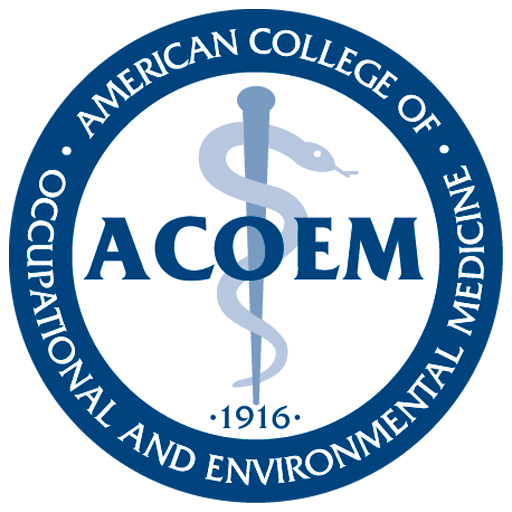
05: Safety In the Workplace
The Unique Medical-Employer Relationship
Occupational medicine is where primary care meets workers in the workplace. Some occupational medicine clinics are located at a worksite or are exclusive to a corporation. In this environment, the occupational medicine provider builds relationships with the company’s staff and may even become one of the staff, caring for fellow workers.
Even if an occupational medicine clinic is not embedded in a corporation, it is still an extension of the work environment. The closer the occupational health provider works with the staff of a company, the greater the opportunity to provide preventive health services and to minimize employees’ time away from work for minor injuries and illnesses.
As a preventive medicine specialty, occupational medicine is population-centric, and here, the population is composed of workers. The provider may examine and treat an individual, but the individual is representative of the larger group. If one individual is introduced to a hazard, whether physical, biological, chemical, or psychological, it is likely that others are also exposed or at risk of being exposed to the same hazard. When an occupational health provider identifies a worker who is injured or ill from a hazard, he or she needs to work with employers to protect other employees.
A Multifaceted Role
Primary care providers fill the majority of occupational health provider roles. These providers are trained for, and accustomed to, the patient being the primary customer. Analogous to parents being customers in a pediatric clinic, employers are customers in an occupational medicine clinic, in that they have a vested interest in the outcome. This situation can be very challenging to a well-meaning primary care provider who was not trained to practice medicine this way. Dealing with privacy concerns and uncertainty about what to discuss with an employer, and understanding who in a workers’ compensation program has a “need to know,” can be difficult. The primary care provider is trained to be a patient advocate first, but when faced with multiple stakeholders involved in a workers’ compensation claim—a necessity when identifying the cause of a complaint, dealing with insurance-carrier provisions, and fielding employer inquiries—this obligation is complicated and not always straightforward.
Although most occupational medicine clinics are independent entities that contract services with employers, they can be perceived as agents of corporate human resources departments, even if their health care providers are not embedded in the employers’ physical facilities. The interaction of employers with the occupational health provider may appear inappropriate if this unique relationship is not well understood. The focus of the occupational health care provider is on the patient, even though the provider simultaneously serves as an advocate for the employer. While this role may seem contradictory, being a patient’s advocate does not mean that a provider must be antagonistic toward the employer. The intermediary role is not so different from other roles that primary care providers play. For example, when working with a patient, they will often take into consideration the entire family’s needs, or when working with an HMO, will consider its limits and policies when providing patient care
Provider-Employer Communication
Occupational health providers perform myriad services for workers, including injury care, employee medical certification, and medical surveillance. Some of these are mandated by OSHA or other regulatory agencies. Some are human-resource directed, and others may be a part of an employee benefit package. At times, supervisors direct workers to be seen in an occupational health clinic.
Following a visit, the occupational health provider is obligated to communicate the results of the evaluation to the supervisor.
Communication of Health Information
Occupational health providers are authorized to handle sensitive information that can affect employment, but only rarely do employers need specific health information to make supervisory decisions for their workers. Typically, the employer requires only information that provides an understanding of function, risk, safety, and hazards, and providers may produce it only if it is free of health information, or with a signed release from the employee, according to HIPAA privacy rules.1
When human resources staff handle protected health information, they must keep it separate from general employee files and under extra security. The best solution is to keep employee health records in the occupational medicine clinic—with the occupational health provider serving as the conduit between the employee and employer, providing only information that is relevant to the position.
In the event of a workers’ compensation claim, however, disclosure of the minimum necessary health information is permitted without individual authorization to the parties involved in the claim, which could include the employer’s human resources department. This exception to HIPAA is needed to allow payment and treatment for injured workers. State workers’ compensation interpretations vary in terms of the types of information that health care providers must convey, but privacy laws still apply, and disclosure must consist of the minimum necessary information.
Communication between the occupational health provider and employer improves when there is a good understanding of what employers want and need to know. Employers need to know whether the worker is able to perform the essential job functions or if there are any limitations or safety concerns.
It is a best practice to communicate worker health information to employers in terms of function rather than diagnosis. The provider may then recommend activity restrictions that allow recovery from an injury or prevent exacerbation. In the case of a worker with a sprained back, for example, the health provider should report not the diagnosis or treatment, but rather that the worker should not lift or carry more than 10 pounds for one week. Communication of the prognosis to the employer is also important because it allows it for planning of job placement and accommodations.
An open working relationship allows the occupational health provider to be aware of the employer’s concerns and the information the company needs to operate safely and within industry regulations. Minor misunderstandings and miscommunication can have large impacts on both the business and workers’ health. Therefore, it is helpful to quantify any restrictions and use standard terminology in workers’ compensation and disability medicine. For example, a provider might recommend that a worker perform a function “rarely.” Rarely is not described by the Department of Labor, and a supervisor or human resources officer may not know how to manage this restriction.
Although primary care providers may feel comfortable using everyday terms, employers must manage workers within strict employment laws, and such terms become difficult to manage.
Occupational health providers may also be the first to hear of concerns in the workplace related to abuse, trauma, or unsafe conditions. Even though safety and human resources departments are tasked with protecting employees, certain barriers may prevent some employees from approaching them. An employee who is unsure of where to turn for help may look to the occupational medicine clinic because he or she trusts the health care system and may have developed a relationship with the provider. This occupational medicine role is essential for the wellness of the worker as well as for the employer. Safety and occupational medicine should work together to identify and investigate troubling allegations.
Occupational health providers should also be familiar with available employee assistance programs and collaborate with human resources to refer workers to these services when needed. The occupational medicine provider can also be very influential in advising employers when there are management decisions to make related to the health of an employee.
Transitional Duty Programs
Employers and providers understand that returning to work with restrictions, rather than remaining off work, accelerates returning to full function and also minimizes overall workers’ compensation costs.
Early return to work also can be physically and mentally therapeutic for the injured worker. Remaining out of work often has negative psychosocial effects, as well as reduces the injured worker’s overall activity level. This leads to physical deconditioning and creates new social and behavioral norms as the worker becomes accustomed to being out of work.
Even though workers’ compensation systems are no fault—meaning that benefits are paid regardless of who is responsible for the injury—many workers will seek legal representation to obtain care and compensation. Occupational health providers who maintain a positive relationship with the employer can be instrumental in ensuring that an injured worker gets the assistance he or she needs, which may reduce the injured worker’s reliance on legal representation.
With representation, an injured worker often receives advice from an attorney whose incentives and strategies for rehabilitation may be very different from those of a collaborative team formed by the worker, employer (including supervisor, human resources officer, and safety officer), insurance provider, and occupational health provider.
The occupational health provider may act as a mediator or liaison with rehabilitation services and the injured worker’s employer to facilitate workplace accommodations and develop a strategy to return to work. Sometimes these providers are employed directly by insurers, the injured worker’s legal representative, or the employer. The work demands of health care providers within the workers’ compensation system can be significant, because they may be required to perform a number of these roles simultaneously while managing patient care. In addition to understanding specific injuries, occupational health providers should understand the work environment, how injuries occur there, and how workers are expected to perform when they return with restrictions.
Most injured workers recover and return to work fairly quickly. It is estimated that 80% of workers’ compensation costs are expended on 20% of workers who have long-term claims. It can be difficult to predict which injuries will take longer to resolve, but when a worker is initially seen, and with every follow up visit, he or she should be prepared for eventual discharge and return to full duty.
Early return to work programs can be very beneficial to rehabilitation, reducing the risk of delayed recovery. These programs are usually designed for workers who were injured on the job, rather than those with non-industrial injuries, although they can benefit both groups in reducing disability and promoting return of function. These programs offer modified work duty until the injured worker is able to resume full duties, but they are not without challenges. For small employers, it can be financially difficult to have a worker in a modified role that is less productive. Moreover, employees may not be agreeable to assigned tasks if they feel they are being given menial work. The social dynamics of returning to work with modified duties can be a problem for the returning worker, who can face resentment or even hostility from coworkers. Workers without obvious injury may lose credibility, accused of being lazy or cheating the system when provided accommodations for work restrictions.2
The scientific evidence regarding return to work programs is lacking, but there is an abundance of research regarding injured athletes returning to the sport. All humans are in essence athletes, and in the case of injured workers, their jobs are their sports. Optimum performance is of course ideal for both productivity and job satisfaction; however, it may not be the immediate goal of a return to work program. Rehabilitation is a stepwise process, and in all stages of recovery, the occupational health provider needs to be cognizant that though rest may seem beneficial, it leads to deconditioning, which makes rehabilitation more difficult. Following a rest period, when there is an increase in activity, injured workers (and athletes alike) naturally feel discomfort because the injury does not vanish with rest, and the worker now has to overcome a deconditioned state. Returning an injured worker back to work, even with modified duty, as early as possible, limits the amount of rest and reduces the risk of this problem.
References
- S. Department of Health & Human Services. Disclosures for Workers’ Compensation Purposes 45 CFR 164.512 (I). https://www.hhs.gov/hipaa/for-professionals/privacy/guidance/disclosures-workers-compensation/index.html. Accessed on 4/13/2018.
- Smith-Young J, Solberg, S, Gaudine A. Constant Negotiating: Managing Work-Related Musculoskeletal Disorders While Remaining at the Workplace. Qualitative Health Research. 2014; February: 1-15.
